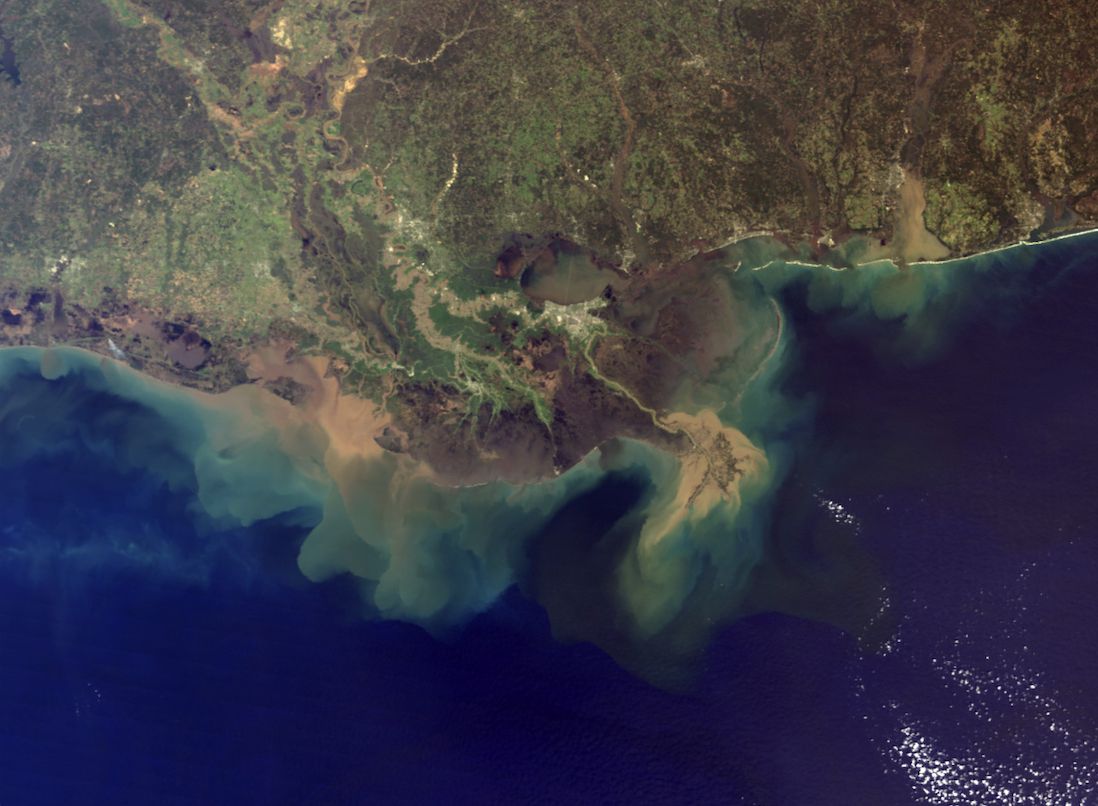
story by Helen Hill for MITgcm
This month we spotlight research using MITgcm to study the impact of including nonseasonal river discharge in a global ocean model.
Insufficient river-gauge data has meant researchers have, until now, had to use seasonal river discharge climatologies in their global ocean models. Given that river discharge is known to have a significant influence on ocean dynamics and biogeochemistry on timescales from days to decades, the recent development of a reanalysis-based daily-varying global river discharge data set prompted a team of researchers at NASA JPL and elsewhere to explore what impact the new data set would have on sea surface salinity and height in a global model.
Hrishikesh Chandanpurkar, Tong Lee, Hong Zhang, Severine Fournier, Ian Fenty, Ichiro Fukumori, Dimitris Menemenlis, John T. Reager, Ou Wang, and John Worden (NASA JPL), together with Xiaochun Wang (UCLA), and Christopher Piecuch (Woods Hole) incorporated the new 0.25 degree resolution discharge data into a higher resolution global implementation of MITgcm and then compared results using regular seasonal climatology with results incorporating the new nonseasonal data set. The paper appears in the Journal of Advances in Modeling Earth Systems,
The team’s model sensitivity experiments were based on an LLC270 configuration of MITgcm. “We used the new nonseasonal river discharge data set to force the model for the period 1992–2017, then contrasted that experiment with another (with identical atmospheric forcings) forced by seasonal climatology from the same discharge data set to isolate nonseasonal discharge effects, focusing on sea surface salinity (SSS) and sea surface height (SSH),” explains lead author Chandanpurkar.
Analyzing their results, Chandanpurkar and his colleagues found that using the new discharge dataset had measurable impacts on SSS and SSH near large rivers. “Near major river mouths, nonseasonal discharge causes standard deviations in SSS of between 1 and 3 practical salinity units and SSH of between 1 and almost 3 cm,” Chandanpurkar says. “It also resulted in notable improvement of model SSS against satellite SSS near most of the tropical-to-midlatitude river mouths as well as minor improvement of model SSH against satellite or in-situ SSH near at least some of the river mouths.” Chandanpurkar also remarked that “The relatively large SSS changes at river mouths due to the inclusion of nonseasonal discharge have strong implications for marine biology, ecosystem, and biogeochemistry.”
To find out more about this work contact Hrishi
Story image: Mississippi sediment plume NASA
About the Researcher
 Hrishikesh Chandanpurkar is a Research Scientist at the University of Saskatchewan, Canada, and a Fellow at the Centre for Earth and Environment at FLAME University, Pune, India. Prior to this, Chandanpurkar was a Postdoctoral Researcher in the Hydrology and Oceanography groups at JPL. His research interests comprise studying large-scale water cycle changes, investigating their climatic- and human- causes, and understanding the implications of these changes on other spheres of the earth system, such as the ocean and the cryosphere, as well as the society and ecosystems. Hrishikesh has been associated with MITgcm since 2018. Outside research, he likes trail running, watercolor sketching, and listening to jazz! 🙂
Hrishikesh Chandanpurkar is a Research Scientist at the University of Saskatchewan, Canada, and a Fellow at the Centre for Earth and Environment at FLAME University, Pune, India. Prior to this, Chandanpurkar was a Postdoctoral Researcher in the Hydrology and Oceanography groups at JPL. His research interests comprise studying large-scale water cycle changes, investigating their climatic- and human- causes, and understanding the implications of these changes on other spheres of the earth system, such as the ocean and the cryosphere, as well as the society and ecosystems. Hrishikesh has been associated with MITgcm since 2018. Outside research, he likes trail running, watercolor sketching, and listening to jazz! 🙂
This Month’s Featured Publication
- Hrishikesh A. Chandanpurkar et al (2022), Influence of Nonseasonal River Discharge on Sea Surface Salinity and Height, JAMES, doi: 10.1029/2021MS002715
Other New Publications last month
F. de Melo Virıssimo, A. P. Martin, and S. A. Henson (2022), Influence of seasonal variability in flux attenuation on global organic carbon fluxes and nutrient distributions, Global Biogeochemical Cycles, doi: 10.1029/2021GB007101
Ferris, Laur. (2022), Across-Scale Energy Transfer in the Southern Ocean, The College of William and Mary, ProQuest Dissertations Publishing, 2022. 28961509,
Demyshev, S.G. and Dovgaya, S.V. (2021), Analysis of Seasonal Energy Characteristics of the Marmara Sea Upper Layer Dynamics. Physical Oceanography, [e-journal], doi:10.22449/1573-160X-2021-5-471-485
Follett, Christopher L., Stephanie Durkiewicz, François Ribalet, Emily Zakem, David Caron, E. Virginia Armbrust, Michael J. Follows (2022), Trophic interactions with heterotrophic bacteria limit the range of Prochlorococcus, Proceedings National Academy of Science, doi: 10.1073/pnas.2110993118
Chao Hu, Xiaoliang Wang, Qingquan Liu (2022), Characteristics of iceberg calving-generated waves based on three-dimensional SPH simulations, Science Direct, doi: 10.1016/j.coastaleng.2022.104090
Ismail, K. and Al-Shehhi, M. R.: Reviews and syntheses: Assessment of Biogeochemical Models in the Marine Environment, Biogeosciences Discuss. [preprint], https://doi.org/10.5194/bg-2021-351, in review, 2022.
Tong Jia, Jianjun Liang, Xiaoming Li, Qiang Li (2022), Progress on Generation of Nonlinear Internal Waves on the Northern Continental Shelf South of Hainan Island, submitted to Journal of Geophysical Research – Oceans, doi: 10.1002/essoar.10509922.1
K. Keller, A. C. Kestelman and L. Bautista-Gomez, Towards Zero-Waste Recovery and Zero-Overhead Checkpointing in Ensemble Data Assimilation, 2021 IEEE 28th International Conference on High Performance Computing, Data, and Analytics (HiPC), 2021, pp. 131-140, doi: 10.1109/HiPC53243.2021.00027
Liu, T., Ou, HW., Liu, X. et al. (2022), The dependence of upper ocean gyres on wind and buoyancy forcing. Geosci. Lett., doi: 10.1186/s40562-022-00213-2
Matthew C. Nixon and Nikku Madhusudhan (2022), Aura-3D: A Three-dimensional Atmospheric Retrieval Framework for Exoplanet Transmission Spectra, arXiv: 2201.03532 [astro-ph.EP]
Benoît Pasquier, François W. Primeau, and Seth G. John (2022), AIBECS.jl: A tool for exploring global marine biogeochemical cycles, JOSS, doi: 10.21105/joss.03814
Pfeil, M. and Slawig, T., (2022), Adaptive time step algorithms for the simulation of marine ecosystem models using the transport matrix method implementation Metos3D (v0.5.0), Geosci. Model Dev. Discuss., doi: 10.5194/gmd-2021-392
Maria Elisabeth Steinrueck (2021), Atmospheric Circulation of Hot Jupiters: Implications of Disequilibrium Chemistry and Photochemical Hazes, University of Arizona doctoral dissertation, Proquest 28866617
Michael R. Stukel, Moira Décima, Michael R. Landry (2022), Quantifying biological carbon pump pathways with a data-constrained mechanistic model ensemble approach, via biorXiv for Biogeosciences, doi: 10.1101/2022.01.07.475464
Xincheng Zhang et al (2022), Submesoscale coherent vortices observed in the northeastern South China Sea, JGR Oceans, doi: 10.1029/2021JC018117
Zheng, Y., Stevens, D. P., Heywood, K. J., Webber, B. G. M., and Queste, B. Y.: Reversal of ocean gyres near ice shelves in the Amundsen Sea caused by the interaction of sea ice and wind, The Cryosphere Discuss. [preprint], https://doi.org/10.5194/tc-2021-390, in review, 2022.
Do you have news about research using MITgcm? We are looking for contributions to these pages. If you have an interesting MITgcm project (ocean, atmosphere, sea-ice, physics, biology or otherwise) that you want to tell people about, get in touch. To make a post, contact Helen
